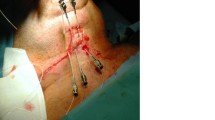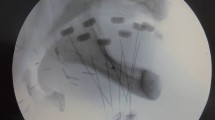Purpose:
To assess the feasibility and acute/delayed toxicity of pulsed-dose-rate brachytherapy (PDR BT) in head-and-neck tumors.
Patients and Methods:
45 head and neck cancer patients underwent interstitial or contact PDR BT at a dose of 10.2–70 Gy (median, 70 Gy) and 0.6 or 1.0 Gy/pulse/h. 42 patients were administered BT as part of their curative treatment; 32 of them had sole BT. Three reirradiated patients with recurrent tumor had palliative BT.
Results:
PDR BT was well tolerated. Intense bleeding was the only complication associated with catheter removal from the tongue and bucca. 44 patients who completed BT experienced acute mucositis. Grade 3 toxicity of skin and oral mucosa occurred in three (6.8%) and six patients (13.6%), respectively. At a median follow-up of 22 months (range, 2–67 months), late serious toxicity (grade 4, for soft tissue and bone) was seen in seven patients (15.9%). Among the parameters analyzed, only dental care performed before BT had a significant impact on mucosal side effects. Acute severe mucositis was observed in 23% of patients without dental care compared to 0% of those with dental care (p = 0.044). Late severe mucositis occurred in 17.7% and 26.9% of the respective patients (p = 0.035), overall in 23%. The larger the volume encompassed by the reference isodose, the more late (p = 0.004) mucosal reactions were observed.
Conclusion:
PDR BT continued over a few days is a feasible and safe approach in head-and-neck tumors; however, it is accompanied by some toxicity. Dental care should precede isotope application.
Ziel:
Bewertung der Anwendungsmöglichkeiten sowie der frühen und späten Toxizität einer Pulsationsbrachytherapie (PDR BT) bei Patienten mit Kopf-Hals-Tumoren.
Patienten und Methodik:
45 Patienten mit Kopf-Hals-Tumoren wurden einer interstitiellen bzw. Kontaktpulsationsbrachytherapie mit einer Dosis von 10,2–70 Gy (Median 70 Gy) und 0,6 oder 1 Gy/Puls/h unterzogen. Bei 42 Patienten wurde die BT als radikale Heilmethode, bei 32 als selbständige Methode und bei zehn als Boost verabreicht. Bei drei Patienten kam die BT als palliative Behandlungsmethode vorbestrahlter Kopf-Hals-Tumoren zur Anwendung.
Ergebnisse:
Die PDR-BT wurde gut vertragen. Die einzige erwähnenswerte Komplikation war eine starke Blutung bei Katheterentfernung aus Zunge und Wange. Bei allen 44 Patienten wurden innerhalb einiger Tage nach Beendigung der PDR-BT akute Nebenwirkungen beobachtet, darunter ernsthafte Grad-3-Toxizität der Haut bei drei (6,8%) und der Schleimhäute bei sechs Patienten (13,6%). Nach einer medianen Beobachtungszeit von 22 Monaten (2–67 Monate) fanden sich schwere späte Nebenwirkungen (Grad 4) an Weichgewebe und Knochen bei sieben Patienten (15,9%). Von den analysierten Parametern hatte nur die vor Beginn der BT durchgeführte zahnärztliche Behandlung wesentlichen Einfluss auf die Verstärkung der Nachbestrahlungsreaktion. Eine akute Nachbestrahlungsreaktion (Grad 3) wurde bei 23% der nicht zahnärztlich vorbehandelten und bei 0% der zahnärztlich vorbehandelten Patienten (p = 0,044) beobachtet. Eine Spätreaktion (Grad 3 und 4) trat bei 17,7% bzw. 26,9% der entsprechenden Patienten auf (p = 0,035), ingesamt bei 23%. Je größer der von der Isodose umfasste Bereich, desto ausgeprägter war die Spätreaktion (p = 0,004) der Schleimhäute.
Schlussfolgerung:
Die über einige Tage verabreichte PDR-BT ist ein geeigneter und gut tolerierter Therapieansatz bei Patienten mit Kopf-Hals-Tumoren, geht jedoch mit einer gewissen Toxizität einher. Vor der Bestrahlung sollte eine zahnärztliche Behandlung durchgeführt werden.
Similar content being viewed by others
Author information
Authors and Affiliations
Corresponding author
Rights and permissions
About this article
Cite this article
Ziemlewski, A., Zienkiewicz, J., Serkies, K. et al. Preliminary Report of Pulsed Dose Rate Brachytherapy in Head-and-Neck Cancer. Strahlenther Onkol 183, 512–516 (2007). https://doi.org/10.1007/s00066-007-1685-2
Received:
Accepted:
Issue Date:
DOI: https://doi.org/10.1007/s00066-007-1685-2




